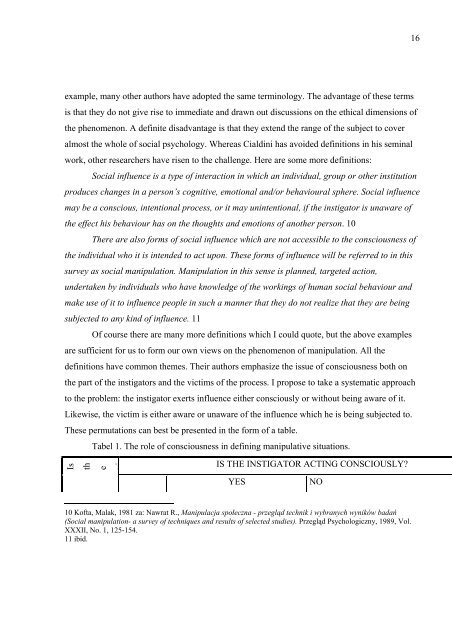PSYCHOMANIPULATION - Tomasz Witkowski
PSYCHOMANIPULATION - Tomasz Witkowski
PSYCHOMANIPULATION - Tomasz Witkowski
Create successful ePaper yourself
Turn your PDF publications into a flip-book with our unique Google optimized e-Paper software.
example, many other authors have adopted the same terminology. The advantage of these terms<br />
is that they do not give rise to immediate and drawn out discussions on the ethical dimensions of<br />
the phenomenon. A definite disadvantage is that they extend the range of the subject to cover<br />
almost the whole of social psychology. Whereas Cialdini has avoided definitions in his seminal<br />
work, other researchers have risen to the challenge. Here are some more definitions:<br />
Social influence is a type of interaction in which an individual, group or other institution<br />
produces changes in a person’s cognitive, emotional and/or behavioural sphere. Social influence<br />
may be a conscious, intentional process, or it may unintentional, if the instigator is unaware of<br />
the effect his behaviour has on the thoughts and emotions of another person. 10<br />
There are also forms of social influence which are not accessible to the consciousness of<br />
the individual who it is intended to act upon. These forms of influence will be referred to in this<br />
survey as social manipulation. Manipulation in this sense is planned, targeted action,<br />
undertaken by individuals who have knowledge of the workings of human social behaviour and<br />
make use of it to influence people in such a manner that they do not realize that they are being<br />
subjected to any kind of influence. 11<br />
Of course there are many more definitions which I could quote, but the above examples<br />
are sufficient for us to form our own views on the phenomenon of manipulation. All the<br />
definitions have common themes. Their authors emphasize the issue of consciousness both on<br />
the part of the instigators and the victims of the process. I propose to take a systematic approach<br />
to the problem: the instigator exerts influence either consciously or without being aware of it.<br />
Likewise, the victim is either aware or unaware of the influence which he is being subjected to.<br />
These permutations can best be presented in the form of a table.<br />
Is<br />
th<br />
Tabel 1. The role of consciousness in defining manipulative situations.<br />
e<br />
vi<br />
IS THE INSTIGATOR ACTING CONSCIOUSLY?<br />
YES NO<br />
10 Kofta, Malak, 1981 za: Nawrat R., Manipulacja społeczna - przegląd technik i wybranych wyników badań<br />
(Social manipulation- a survey of techniques and results of selected studies). Przegląd Psychologiczny, 1989, Vol.<br />
XXXII, No. 1, 125-154.<br />
11 ibid.<br />
16


